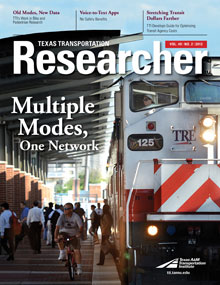
Agency Director
If you’re a regular reader of this column, you might have noticed a couple of recurrent themes over the past few years.
First, I think the Texas A&M Transportation Institute (TTI) is the best agency conducting transportation research in the world today. Admittedly, I’m a little biased in that opinion. But I can say, objectively, that the breadth and depth of the Institute’s research portfolio give us both a big-picture perspective on the transportation system as a whole and detailed insight into the “little pictures” that make up that mosaic.
“Doing more with less” is a second theme that might sound familiar. You’ve heard me say it before: maintenance and construction costs are up, while public agency budgets are down. Doing more with less is not just a fiscal mantra anymore; it’s a strategy for survival. It’s simply become too expensive to build our way out of mobility problems, so we must squeeze more capacity out of the system we have. That’s where multimodalism comes in.
Meeting today’s transportation challenges is — like the big picture, when you look a little closer — made up of multiple, smaller goals. In this issue, we look at the various little pictures of capacity building — bikes and pedestrians, transit, waterways, air traffic and intercity rail. TTI experts, grounded in their particular disciplines, provide answers to how these different modes can help optimize how we use our overall transportation network.
And since we’re talking about diversity in research, I’d like to acknowledge two honors TTI recently received. I don’t wish to crow about these achievements (well, maybe just a little), but given how important broad-based research expertise is today, they’re worth noting here. The Heart of Texas Chapter of the Women’s Transportation Seminar (WTS) recently named TTI its Employer of the Year. This honor follows a similar recognition back in September 2011, when the American Road and Transportation Builders Association (ARTBA) bestowed its Glass Hammer Award on the Institute.
Both awards recognize TTI for its leadership in promoting women leaders in transportation. We’ve made it a priority to inspire young women to pursue transportation engineering as early as the sixth grade, as well as to recruit women professionals to work for the Institute. We rely on their leadership at all levels in TTI as demonstrated by Executive Associate Director Katie Turnbull’s recent participation in a White House special forum on women in transportation. Without the range of expertise inherent to initiatives like these, TTI research would not be nearly as effective in finding solutions to the variety of transportation problems we face today.
We’re extremely grateful for and humbled by the recognition from WTS and ARTBA. I see it not only as an endorsement of our efforts to encourage women to pursue careers in transportation, but also as evidence that TTI’s approach to expanding its research capacity and capability is on the right track (or roadway or path or canal).

